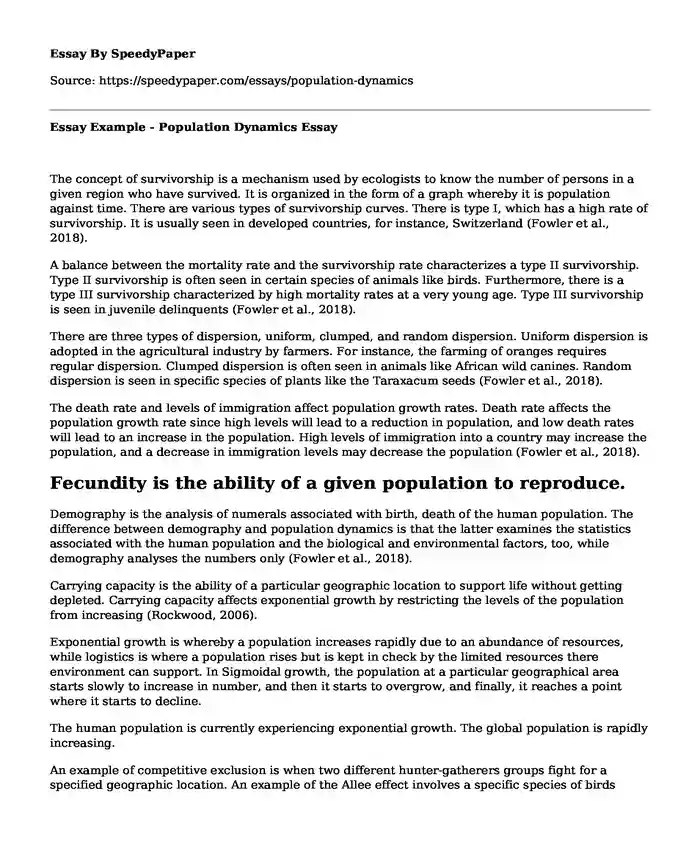
| Essay type: | Definition essays |
| Categories: | Biology Ecology Population |
| Pages: | 3 |
| Wordcount: | 730 words |
The concept of survivorship is a mechanism used by ecologists to know the number of persons in a given region who have survived. It is organized in the form of a graph whereby it is population against time. There are various types of survivorship curves. There is type I, which has a high rate of survivorship. It is usually seen in developed countries, for instance, Switzerland (Fowler et al., 2018).
A balance between the mortality rate and the survivorship rate characterizes a type II survivorship. Type II survivorship is often seen in certain species of animals like birds. Furthermore, there is a type III survivorship characterized by high mortality rates at a very young age. Type III survivorship is seen in juvenile delinquents (Fowler et al., 2018).
There are three types of dispersion, uniform, clumped, and random dispersion. Uniform dispersion is adopted in the agricultural industry by farmers. For instance, the farming of oranges requires regular dispersion. Clumped dispersion is often seen in animals like African wild canines. Random dispersion is seen in specific species of plants like the Taraxacum seeds (Fowler et al., 2018).
The death rate and levels of immigration affect population growth rates. Death rate affects the population growth rate since high levels will lead to a reduction in population, and low death rates will lead to an increase in the population. High levels of immigration into a country may increase the population, and a decrease in immigration levels may decrease the population (Fowler et al., 2018).
Fecundity is the ability of a given population to reproduce.
Demography is the analysis of numerals associated with birth, death of the human population. The difference between demography and population dynamics is that the latter examines the statistics associated with the human population and the biological and environmental factors, too, while demography analyses the numbers only (Fowler et al., 2018).
Carrying capacity is the ability of a particular geographic location to support life without getting depleted. Carrying capacity affects exponential growth by restricting the levels of the population from increasing (Rockwood, 2006).
Exponential growth is whereby a population increases rapidly due to an abundance of resources, while logistics is where a population rises but is kept in check by the limited resources there environment can support. In Sigmoidal growth, the population at a particular geographical area starts slowly to increase in number, and then it starts to overgrow, and finally, it reaches a point where it starts to decline.
The human population is currently experiencing exponential growth. The global population is rapidly increasing.
An example of competitive exclusion is when two different hunter-gatherers groups fight for a specified geographic location. An example of the Allee effect involves a specific species of birds called passenger pigeon (Rockwood, 2006).
Predation is a process whereby one species of animal kills another for prey. Predation is critical in evolution since the more a particular type of animal is scared to its enemies, it will increase changes to the animal, thereby changing (Fowler et al., 2018).
The three symbiotic relationships are commensalism, parasitism, and mutualism. In mutualism relationships, both partners benefit, while in commensalism, only one partner benefits, and is not altered in any way. In parasitism, only one species benefits at the expense of the other species and often harms the species (Rockwood, 2006).
If the top predator is removed from an ecological community, the prey will increase in number. For instance, if lions are removed from Africa's savannahs, the antelopes, gazelle, and zebras will increase in number.
Succession is the process, which depicts the changes that happen to plants for a specified period. Several disturbances can disrupt succession, including fires, diseases, and insect infestation (Rockwood, 2006).
Mimicry is when a particular species of animals imitate another species of animals in terms of sound, behaviors, and even smells, while camouflage is whereby a certain species changes its body to protect itself from enemies.
There are three types of mimicry, namely Mertensian, Muellerian, and Batesian mimicry. In Batesian mimicry, the said species of animal resembles other animal species but does not have its traits. In Müllerian, two harmful species reciprocally expose themselves as harmful. In Mertensian, a dangerous mimic resembles a less dangerous but lesson-teaching pattern (Rockwood, 2006).
References
Fowler, S., Roush, R., & Wise, J. (2018). Concepts of biology. Samurai Media Limited, 2018.
Rockwood, L. (2006). Introduction to population ecology (1st ed.). John Wiley & Sons, 2009.
Cite this page
Essay Example - Population Dynamics. (2023, Oct 23). Retrieved from https://speedypaper.net/essays/population-dynamics
Request Removal
If you are the original author of this essay and no longer wish to have it published on the SpeedyPaper website, please click below to request its removal:
- Oceanography Essay Example: The Blob
- Colonial Williamsburg, Free Essay Example for Students
- Essay Example on Iranian Revolution in 1979
- Free Essay Example. a Hip Labral Tear
- Free Essay. Impact of the Immigration Restriction Act (1901) in Australia in the 20th Century
- Essay Sample on Body Dysmorphic Disorder (BDD)
- The Contamination of Air by Lead. Free Essay
Popular categories




